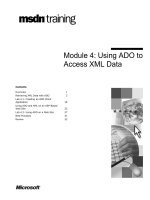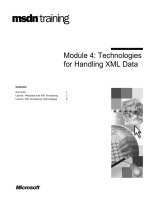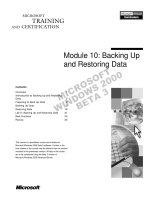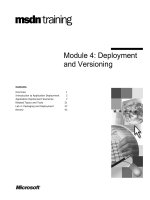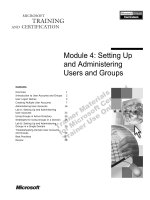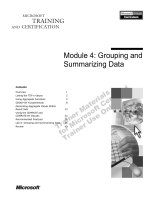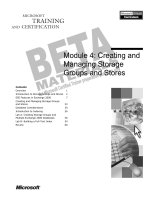CHFI module 4: Data acquisition and duplication
Bạn đang xem bản rút gọn của tài liệu. Xem và tải ngay bản đầy đủ của tài liệu tại đây (6.03 MB, 77 trang )
Data Acquisition and
Duplication
Module 04
Computer Hacking Forensic Investigator
Data Acquisition and Duplication
Exam 312-49
Data Acquistion and
Duplication
Module 04
Designed by Cyber Crime Investigators. Presented by Professionals.
Copyright © by EC-Council. All Rights Reserved. Reproduction is Strictly Prohibited.
Computer Hacking Forensic Investigator v9
Module 04: Data Acquisition and Duplication
Exam 312-49
Module 04 Page 387
Computer Hacking Forensic Investigator Copyright © by EC-Council
All Rights Reserved. Reproduction is Strictly Prohibited.
Computer Hacking Forensic Investigator
Data Acquisition and Duplication
Exam 312-49
Module Objectives
After successfully completing this module, you will be able to:
1
Understand data acquisition and its importance
2
Understand live data acquisition
3
Understand static data acquisition
4
Review data acquisition and duplication steps
5
Choose the steps required to keep the device unaltered
6
Determine the best acquisition method and select appropriate data acquisition tool
7
Perform the data acquisition on Windows and Linux Machines
8
Summarize data acquisition best practices
Copyright © by EC-Council. All Rights Reserved. Reproduction is Strictly Prohibited.
Data acquisition is the first pro-active step in the forensic investigation process. The aim of
forensic data acquisition is to extract every bit of information present on the victim’s hard disk
and create a forensic copy to use it as evidence in the court. In some cases, data duplication is
preferable instead of data acquisition to collect the data. Investigators can also present the
duplicated data in court.
Module 04 Page 388
Computer Hacking Forensic Investigator Copyright © by EC-Council
All Rights Reserved. Reproduction is Strictly Prohibited.
Computer Hacking Forensic Investigator
Data Acquisition and Duplication
Exam 312-49
Understanding Data Acquisition
Data acquisition is the use of established methods to extract the Electronically Stored
Information (ESI) from suspect computer or storage media to gain insight into a crime
or an incident
It is one of the most critical steps of digital forensics as improper acquisition may alter
data in evidence media, and render it inadmissible in the court of law
Investigators should be able to verify the accuracy of acquired data, and the complete
process should be auditable and acceptable to the court
Types of Data Acquisition
Live Data Acquisition
Involves collecting volatile information that
resides in registries, cache, and RAM
Static Data Acquisition
Acquisition of data that remains unaltered
even if the system is powered off
Copyright © by EC-Council. All Rights Reserved. Reproduction is Strictly Prohibited.
Forensic data acquisition is a process of imaging or collecting information from various media in
accordance with certain standards for analyzing its forensic value. With the progress of
technology, the process of data acquisition has become more accurate, simple, and versatile. It
uses many types of electronic equipment, ranging from small sensors to sophisticated
computers. Following are the two categories of data acquisition:
Live Data Acquisition
It is the process of acquiring volatile data from a working computer (either locked or in sleep
condition) that is already powered on. Volatile data is fragile and lost when the system loses
power or the user switches it off. Such data reside in registries, cache, and RAM. Since RAM and
other volatile data are dynamic, a collection of this information should occur in real time.
Static Data Acquisition
It is the process of acquiring the non-volatile or unaltered data remains in the system even after
shutdown. Investigators can recover such data from hard drives as well as from slack space,
swap files, and unallocated drive space. Other sources of non-volatile data include CD-ROMs,
USB thumb drives, smartphones, and PDAs.
The static acquisition is usually applicable for the computers the police had seized during the
raid and include an encrypted drive.
Module 04 Page 389
Computer Hacking Forensic Investigator Copyright © by EC-Council
All Rights Reserved. Reproduction is Strictly Prohibited.
Computer Hacking Forensic Investigator
Data Acquisition and Duplication
Exam 312-49
Live Data Acquisition
One chance to collect
- After the system is rebooted or shut down, it’s too late!
Copyright © by EC-Council. All Rights Reserved. Reproduction is Strictly Prohibited.
Module 04 Page 390
Computer Hacking Forensic Investigator Copyright © by EC-Council
All Rights Reserved. Reproduction is Strictly Prohibited.
Computer Hacking Forensic Investigator
Data Acquisition and Duplication
Exam 312-49
Live Data Acquisition
As RAM and other volatile data are dynamic, collection of this information should occur in real time
Potential evidence may be lost or destroyed even by simply looking through files on a running computer
or by booting up the computer to “look around” or playing games on it
In volatile data collection, contamination is harder to control because tools and commands may change
file access dates and times, use shared libraries or DLLs, trigger the execution of malicious software
(malware), or—in the worst case—force a reboot and lose all volatile data
Volatile information assists in determining a logical timeline of the security incident, and the possible
users responsible
Types of volatile data
System Information
Collection of information about the current
configuration and running state of the suspicious
computer
Volatile system information includes system profile
(details about configuration), current system date
and time, command history, current system
uptime, running processes, open files, start up files,
clipboard data, logged on users, and DLL s or
shared libraries
Network Information
Collection of information about the network state of
the suspicious computer
Volatile network information includes open
connections and ports, routing information and
configuration, and ARP cache
Copyright © by EC-Council. All Rights Reserved. Reproduction is Strictly Prohibited.
Live data acquisition is the process of extracting volatile information present in the registries,
cache, and RAM of digital devices through its normal interface. The volatile information is
dynamic in nature and changes with time, therefore, the investigators should collect the data in
real time.
Simple actions such as looking through the files on a running computer or booting up the
computer have the potential to destroy or modify the available evidence data, as it is not writeprotected. Additionally, contamination is harder to control because the tools and commands
may change file access dates and times, use shared libraries or DLLs, trigger the execution of
malicious software (malware), or—worst case—force a reboot that results in losing of all
volatile data. Therefore, the investigators must be very careful while performing the live
acquisition process. Volatile information assists in determining a logical timeline of the security
incident, network connections, command history, processes running, connected peripherals
and devices, as well as the users, logged onto the system.
Depending on the source, there are the following two types of volatile data:
System Information
System information is the information related to a system that can act as evidence in a criminal
or security incident. This information includes the current configuration and running state of
the suspicious computer. Volatile system information includes system profile (details about
configuration), login activity, current system date and time, command history, current system
uptime, running processes, open files, startup files, clipboard data, logged on users, DLLs, or
Module 04 Page 391
Computer Hacking Forensic Investigator Copyright © by EC-Council
All Rights Reserved. Reproduction is Strictly Prohibited.
Computer Hacking Forensic Investigator
Data Acquisition and Duplication
Exam 312-49
shared libraries. The system information also includes critical data stored in slack spaces of hard
disk drive.
Network Information
Network information is the network related information stored in the suspicious system and
connected network devices. Volatile network information includes open connections and ports,
routing information and configuration, ARP cache, shared files, services accessed, etc.
Module 04 Page 392
Computer Hacking Forensic Investigator Copyright © by EC-Council
All Rights Reserved. Reproduction is Strictly Prohibited.
Computer Hacking Forensic Investigator
Data Acquisition and Duplication
Exam 312-49
Order of Volatility
When collecting evidence, the collection should proceed from the most volatile to the least
volatile
The list below is the order of volatility for a typical system:
1
Registers, and cache
2
3
Temporary file systems
4
Disk or other storage media
Remote logging and monitoring data that is relevant to the system
in question
5
6
7
Routing table, process table, kernel statistics, and memory
Physical configuration, and network topology
Archival media
Copyright © by EC-Council. All Rights Reserved. Reproduction is Strictly Prohibited.
Investigators should always remember that the entire data do not have the same level of
volatility and collect the most volatile data at first, during live acquisitions. The order of
volatility for a typical computer system is as follows:
Registers, cache: The information in the registers or the processor cache on the
computer exists around for a matter of nanoseconds. They are always changing and are
the most volatile data.
Routing table, process table, kernel statistics, and memory: A routing table, ARP cache,
kernel statistics information is in the ordinary memory of the computer. These are a bit
less volatile than the information in the registers, with the life span of ten nanoseconds.
Temporary file systems: Temporary file systems tend to be present for a longer time on
the computer compared to routing tables, ARP cache, etc. These systems are eventually
over written or changed, sometimes in seconds or minutes later.
Disk or other storage media: Anything stored on a disk stays for a while. However,
sometimes, things could go wrong and erase or write over that data. Therefore, disk
data are also volatile with a lifespan of some minutes.
Remote logging and monitoring data related to the target system: The data that goes
through a firewall generates logs in a router or in a switch. The system might store these
logs somewhere else. The problem is that these logs can over write themselves,
sometimes a day later, an hour later, or a week later. However, generally they are less
volatile than a hard drive.
Module 04 Page 393
Computer Hacking Forensic Investigator Copyright © by EC-Council
All Rights Reserved. Reproduction is Strictly Prohibited.
Computer Hacking Forensic Investigator
Data Acquisition and Duplication
Exam 312-49
Physical configuration, network topology: Physical configuration and network topology
are less volatile and have more life span than some other logs.
Archival media: A DVD-ROM, a CD-ROM or a tape can have the least volatile data
because the digital information is not going to change in such data sources
automatically any time unless damaged under a physical force.
Module 04 Page 394
Computer Hacking Forensic Investigator Copyright © by EC-Council
All Rights Reserved. Reproduction is Strictly Prohibited.
Computer Hacking Forensic Investigator
Data Acquisition and Duplication
Exam 312-49
Common Mistakes in Volatile
Data Collection
Assuming that some
parts of the
suspicious machine
may be reliable and
usable (Using native
commands on the
suspicious computer
may trigger time
bombs, malware,
and Trojans to delete
key volatile data)
Shutting down or
rebooting the
suspicious computer
(connections and
running processes
are closed, and MAC
times are changed)
Not having access to
baseline
documentation
about the suspicious
computer
Not documenting
the data collection
process
Copyright © by EC-Council. All Rights Reserved. Reproduction is Strictly Prohibited.
The investigators should collect the volatile data carefully because any mistake would result in
permanent data loss.
Module 04 Page 395
Computer Hacking Forensic Investigator Copyright © by EC-Council
All Rights Reserved. Reproduction is Strictly Prohibited.
Computer Hacking Forensic Investigator
Data Acquisition and Duplication
Exam 312-49
Volatile Data Collection
Methodology
Step 1
Step 2
Incident Response Preparation
Incident Documentation
The following items should be in
place before an incident occurs:
Ensure the generated logs, and
profiles are organized and
readable
Document all the information
about the security incident and
use a logbook to record all the
actions performed during data
collection
Use the first responder toolkit
logbook to determine the tools
appropriate for the situation
A first responder toolkit
(response disk)
An incident response team (IRT)
or a designated first responder
Forensics-related policies that
allow for forensic collection
Step 3
Policy Verification
Ensure the actions you plan to
take do not violate existing
network and computer usage
policies
Do not violate any rights of the
registered owner or user of the
suspicious system
Copyright © by EC-Council. All Rights Reserved. Reproduction is Strictly Prohibited.
The volatile data collection plays a major role in the crime scene investigation. To ensure no
loss occur during the collection of critical evidence, the investigators should follow the proper
methodology and provide a documented approach for performing activities in a responsible
manner.
The step-by-step procedure of the volatile data collection methodology:
Step 1: Incident Response Preparation
Eliminating or anticipating every type of security incident or threat is not possible practically.
However, to collect all kinds of volatile data, responders can be prepared to react to the
security incident successfully.
The following should be ready before an incident occurs:
A first responder toolkit (responsive disk)
An incident response team (IRT) or designated first responder
Forensic-related policies that allow forensic data collection
Step 2: Incident Documentation
Ensure to store the logs and profiles in organized and readable format. For e.g., use naming
conventions for forensic tool output, record time stamps of log activities and include the
identity of the forensic investigator. Document all the information about the security incident
Module 04 Page 396
Computer Hacking Forensic Investigator Copyright © by EC-Council
All Rights Reserved. Reproduction is Strictly Prohibited.
Computer Hacking Forensic Investigator
Data Acquisition and Duplication
Exam 312-49
needs and maintain a logbook to record all actions during the forensic collection. Using the first
responder toolkit logbook helps to choose the best tools for the investigation.
Step 3: Policy Verification
Ensure that the actions planned do not violate the existing network and computer usage
policies and any rights of the registered owner or user as well. Points to consider for policy
verification:
Read and examine all the policies signed by the user of the suspicious computer.
Determine the forensic capabilities and limitations of the investigator by determining
the legal rights (including a review of federal statutes) of the user.
Module 04 Page 397
Computer Hacking Forensic Investigator Copyright © by EC-Council
All Rights Reserved. Reproduction is Strictly Prohibited.
Computer Hacking Forensic Investigator
Data Acquisition and Duplication
Exam 312-49
Volatile Data Collection
Methodology (Cont’d)
Step 4
Volatile Data Collection Strategy
No two security incidents will be the same. Use the first responder toolkit logbook, and the
questions from the graphic to develop the volatile data collection strategy that suits the
situation and leaves the smallest possible footprint on the suspicious system
Volatile Data Collection Setup
Step 5
Establish a trusted command shell
Do not open, or use a command shell or terminal from the suspicious system. This minimizes
the footprint on the suspicious system and restricts the triggering of any kinds of malware that
have been installed on the system
Establish the transmission and storage method
Identify and record how the data could be transmitted from the live suspicious computer to a
remote data collection system as there will not be enough space on the response disk to collect
forensics tools’ output
EX: Netcat and Cryptcat that transmit data remotely via a network
Ensure the integrity of forensic tool output
Compute an MD5 hash of forensics tools’ output to ensure the integrity and admissibility
Copyright © by EC-Council. All Rights Reserved. Reproduction is Strictly Prohibited.
Step 4: Volatile Data Collection Strategy
Security incidents are not similar. The first responder toolkit logbook and the questions from
the graphic to create the volatile data collection strategy that suits the situation and leaves a
negligible amount of footprint on the suspicious system should be used.
Devise a strategy based on considerations such as the type of volatile data, the source of the
data, type of media used, type of connection, etc. Make sure to have enough space to copy the
complete information.
Step 5: Volatile Data Collection Setup
Establish a trusted command shell: Do not open or use a command shell or terminal of
the suspicious system. This action minimizes the footprint on the suspicious system and
stops any kind of malware to trigger on the system.
Establish the transmission and storage method: Identify and record the data
transmission process from the live suspicious computer to the remote data collection
system, as there will not be enough space on the responsive disk to collect forensic tool
output. For e.g., Netcat and Cryptcat can transmit data remotely via a network.
Ensure the integrity of forensic tool output: Compute an MD5 hash of the forensic tool
output to ensure the integrity and admissibility.
Module 04 Page 398
Computer Hacking Forensic Investigator Copyright © by EC-Council
All Rights Reserved. Reproduction is Strictly Prohibited.
Computer Hacking Forensic Investigator
Data Acquisition and Duplication
Exam 312-49
Volatile Data Collection
Methodology (Cont’d)
Step 6
Volatile Data Collection Process
Do not shut down or restart a system under investigation until all relevant volatile data has been recorded
Maintain a log of all actions performed on the running machine
Photograph the screen of the running system to document its state
Identify the operating system running on the suspect machine
Note system date, time and command history, if shown on screen, and compare with the current actual time
Check the system for the use of whole disk or file encryption
Do not use the administrative utilities on the compromised system during an investigation, and be cautious
particularly when running diagnostic utilities
As you execute each forensics tool or command, generate the date and time to establish an audit trail
Dump the RAM from the system to a forensically sterile removable storage device
Collect other volatile operating system data and save to a removable storage device
Determine evidence seizure method (of hardware and any additional artifacts on the hard drive that may be
determined to be of evidentiary value)
Complete a full report documenting all steps and actions taken
Copyright © by EC-Council. All Rights Reserved. Reproduction is Strictly Prohibited.
Step 6: Volatile Data Collection Process
Record the time, date, and command history of the system
To establish an audit trail generate dates and times while executing each forensic tool or
command
Start a command history to document all the forensic collection activities. Collect all
possible volatile information from the system and network
Do not shut down or restart a system under investigation until all relevant volatile data
has been recorded
Maintain a log of all actions conducted on a running machine
Photograph the screen of the running system to document its state
Identify the operating system (OS) running on the suspect machine
Note system date, time and command history, if shown on screen, and record with the
current actual time
Check the system for the use of whole disk or file encryption
Do not use the administrative utilities on the compromised system during an
investigation, and particularly be cautious when running diagnostic utilities
Module 04 Page 399
Computer Hacking Forensic Investigator Copyright © by EC-Council
All Rights Reserved. Reproduction is Strictly Prohibited.
Computer Hacking Forensic Investigator
Data Acquisition and Duplication
Exam 312-49
As each forensic tool or command is executed, generate the date and time to establish
an audit trail
Dump the RAM from the system to a forensically sterile removable storage device
Collect other volatile OS data and save to a removable storage device
Determine evidence seizure method (of hardware and any additional artifacts on the
hard drive that may be determined to be of evidentiary value)
Complete a full report documenting all steps and actions taken
Module 04 Page 400
Computer Hacking Forensic Investigator Copyright © by EC-Council
All Rights Reserved. Reproduction is Strictly Prohibited.
Computer Hacking Forensic Investigator
Data Acquisition and Duplication
Exam 312-49
Static Data Acquisition
Copyright © by EC-Council. All Rights Reserved. Reproduction is Strictly Prohibited.
Module 04 Page 401
Computer Hacking Forensic Investigator Copyright © by EC-Council
All Rights Reserved. Reproduction is Strictly Prohibited.
Computer Hacking Forensic Investigator
Data Acquisition and Duplication
Exam 312-49
Static Data Acquisition
Static data acquisition is defined as acquiring data that remains unaltered when
the system is powered off or shutdown
This type of data is termed as non-volatile and is usually recovered from hard
drives. It can also exist in slack space, swap files and, unallocated drive space
Other sources of non-volatile data include DVD-ROMs, USB drives, flash cards,
smart phones, and external hard drives
Examples of static data: emails, word processing documents, Web activity,
spreadsheets, slack space, swap files, unallocated drive space, and various
deleted files
Copyright © by EC-Council. All Rights Reserved. Reproduction is Strictly Prohibited.
Static data refer to the non-volatile data, which does not change its state after the system shut
down. Static data acquisition refers to the process of extracting and gathering the unaltered
data from storage media. Sources of non-volatile data include hard drives, DVD-ROMs, USB
drives, flash cards, smart-phones, external hard drives, etc. This type of data exists in the form
of emails, word processing documents, web activity, spreadsheets, slack space, swap files,
unallocated drive space, and various deleted files. Investigators can repeat the static
acquisitions on well-preserved disk evidence.
Static data recovered from a hard drive includes:
Temporary (temp) files
System registries
Event/system logs
Boot sectors
Web browser cache
Cookies
Hidden files
Module 04 Page 402
Computer Hacking Forensic Investigator Copyright © by EC-Council
All Rights Reserved. Reproduction is Strictly Prohibited.
Computer Hacking Forensic Investigator
Data Acquisition and Duplication
Exam 312-49
Rules of Thumb
Do not work on original digital evidence. Work on the bit-stream image of a
suspicious drive/file to view the static data
Produce two copies of the original media
The first is the working copy to be used for analysis
The second is the library/control copy that is stored for disclosure purposes or in the
event that the working copy gets corrupt
If performing a drive-to-drive imaging, use clean media to copy to shrink-wrapped
new drives
Once duplication of original media is done, verify the integrity of copies to the
original
The better the quality of evidence, the better the analysis and likelihood of solving the crime
Copyright © by EC-Council. All Rights Reserved. Reproduction is Strictly Prohibited.
Rule of thumb refers to the best practice of a process that helps to ensure a favorable outcome
on application. In the case of a digital forensics investigation, “The better the quality of
evidence, the better the analysis and likelihood of solving the crime.”
Never perform a forensic investigation or any other process on the original evidence or source
of evidence as it may alter the data and leave the evidence ineligible in the court of law.
Instead, create a duplicate bit-stream image of a suspicious drive/file to view the static data
and work on it. This practice will not only preserve the original evidence, but also provide a
chance to recreate a duplicate if something goes wrong.
Always produce two copies of the original media before starting the investigation process for
the following purposes:
One copy is the working copy, for analysis
One copy is the library/control copy stored for disclosure purposes or in the event that
the working copy gets corrupted
If the investigators need to perform a drive-to-drive imaging, use blank media to copy to shrink
wrapped new drives. After duplicating the original media, verify the integrity of copies to the
original using hash values such as MD5.
Module 04 Page 403
Computer Hacking Forensic Investigator Copyright © by EC-Council
All Rights Reserved. Reproduction is Strictly Prohibited.
Computer Hacking Forensic Investigator
Data Acquisition and Duplication
Exam 312-49
Why Create a Duplicate Image?
The computer/media is a crime scene and it should be protected to ensure that the
evidence is not contaminated
Duplicate image allows the following:
Preserves the original evidence
Only One Chance to Do it Right
Prevents inadvertent alteration of
original evidence during examination
Allows recreation of the duplicate
image if necessary
Evidence can be duplicated with no
degradation from copy to copy
Duplicating
Original Hard Disk
Duplicate Hard Disk
Copyright © by EC-Council. All Rights Reserved. Reproduction is Strictly Prohibited.
Digital data are more susceptible to loss, damage, and corruption unless the investigators
preserve and handle it properly. Prior to examination, the investigators should forensically
image or duplicate the electronic device data and keep two or more copies. Forensic
investigators should use only the image data for their investigation.
Module 04 Page 404
Computer Hacking Forensic Investigator Copyright © by EC-Council
All Rights Reserved. Reproduction is Strictly Prohibited.
Computer Hacking Forensic Investigator
Data Acquisition and Duplication
Exam 312-49
Bit Stream Image Vs. Backups
Bit Stream Image
Backups
Bit stream image (also referred to as mirror
image/evidence-grade backups) involves a
bit-by-bit copy of a physical hard drive or
any other storage media
Most operating systems pay attention only
to the live file system structure
It exactly duplicates all sectors on a given
storage device
Backups usually do not capture this data,
and modify the timestamps of data,
contaminating the timeline
This includes hidden and residual data (slack,
space, swap, unused space, residue, and
deleted files)
Slack, residue, deleted files, etc., are not
indexed
Bit stream programs rely on cyclic redundancy
check (CRC) computations in the validation
process
Copyright © by EC-Council. All Rights Reserved. Reproduction is Strictly Prohibited.
Bit-Stream Image
Bit-stream imaging, also known as mirror images and evidence grade backups, is the process of
creating a duplicate of a hard disk through bit-by-bit copying of its data onto another storage
media. The process copies all the sectors of a target drive, including the hidden and residual
data, such as slack space, unused space, residue, swap files, deleted files, etc. Bit-stream
programs depend on CRC computations in the validation process.
This type of imaging requires more space and takes more time for completion.
Backups
Backup refers to the process of copying and archiving of system data, which can help to restore
the system to its previous state in case of a breakdown, security incident or data loss. Backups
do not capture the same or complete disk data; instead, they include OS data such as the live
file system structure. This type of data duplication does not contain slack space, deleted files,
residue, etc.
This process often modifies the timestamps and other features, thus contaminating the
timeline.
Module 04 Page 405
Computer Hacking Forensic Investigator Copyright © by EC-Council
All Rights Reserved. Reproduction is Strictly Prohibited.
Computer Hacking Forensic Investigator
Data Acquisition and Duplication
Exam 312-49
Issues with Data Duplication
Data duplication may
contaminate the original
data, which then would
not be accepted as
evidence
There are chances
of tampering with
the duplicate data
Data fragments can be
overwritten, and data
stored in the Windows
swap file can be altered
or destroyed
If the original data is contaminated, then
important evidence is lost, which causes
problems in the investigation process
Copyright © by EC-Council. All Rights Reserved. Reproduction is Strictly Prohibited.
Data Duplication is the process of creating a copy of data that is a replica of the original source.
The various issues associated with data duplication are:
Data duplication process can sometimes overwrite the data fragments and damage its
integrity
The process can alter the data stored in the Windows swap file, which temporarily
stores the information a RAM does not use
During the data duplication, the device used to copy can also write the data to the
original evidence source and destroy its authenticity, leaving it unacceptable in the
court of law
In case of contamination of the original data, the critical evidence is lost, which causes
problems in the investigation process
There are chances of tampering with the duplicate data as well
Module 04 Page 406
Computer Hacking Forensic Investigator Copyright © by EC-Council
All Rights Reserved. Reproduction is Strictly Prohibited.
Computer Hacking Forensic Investigator
Data Acquisition and Duplication
Exam 312-49
Data Acquisition and
Duplication Steps
Prepare a Chain of Custody document
Enable Write Protection on the Evidence
Media
Sanitize the Target Media
Determine the Data Acquisition Format
Determine the Best Acquisition Method
Select the Data Acquisition Tool
Acquire the Data
Plan for Contingency
Validate Data Acquisitions
Copyright © by EC-Council. All Rights Reserved. Reproduction is Strictly Prohibited.
Data acquisition is the first pro-active step in the forensic investigation process. The aim of
forensic data acquisition is to make a forensic copy of data, which can act as evidence in the
court.
Forensic data duplication refers to the creation of a file that has every bit of information from
the source in a raw bit-stream format. Steps to follow in the process of data acquisition and
data duplication are:
Prepare a chain of custody document and make a note of all the actions performed over
the evidence source and data, along with the names of investigators performing the
task, the time and date, and the result
Enable write protection on the evidence media as most of the devices have two-way
communication enabled and can alter the data in source of evidence
Sanitize the target media, which is going to hold a copy of the evidence data
Determine the data acquisition format before starting the process and see that the copy
remains in the same format as the original data
Analyze the requirements and select the best acquisition method
Select the appropriate data acquisition tool, which can serve all the actions required
while ensuring safety of the data
Acquire the complete data along with hidden and encrypted spaces
Module 04 Page 407
Computer Hacking Forensic Investigator Copyright © by EC-Council
All Rights Reserved. Reproduction is Strictly Prohibited.
Computer Hacking Forensic Investigator
Data Acquisition and Duplication
Exam 312-49
Have contingency plans in case of an incident
After completion of duplication, validate data acquisitions to check the integrity and
completeness of the data
Module 04 Page 408
Computer Hacking Forensic Investigator Copyright © by EC-Council
All Rights Reserved. Reproduction is Strictly Prohibited.
Computer Hacking Forensic Investigator
Data Acquisition and Duplication
Exam 312-49
Prepare a Chain of Custody
Document
Prepare chain of custody
document to track and ensure the
integrity of collected evidence
The chain of custody document, at
the minimum, should have the
following information:
Description of the evidence
Time of collection
Location from where it was
collected
Details of the people who handled it
Reason for the person to handle it
Copyright © by EC-Council. All Rights Reserved. Reproduction is Strictly Prohibited.
A chain of custody is a written record consisting of all the processes involved in the seizure,
custody, control, transfer, analysis, and disposition of physical or electronic evidence. It also
includes the details of people, time, and purpose involved in the investigation and evidence
maintenance processes.
Chain of custody documents, track collected information and preserve the integrity of the
collected evidence. It should contain details of every action performed during the process and
the result. The forensic investigators are always responsible for the protection of the chain of
custody document.
Module 04 Page 409
Computer Hacking Forensic Investigator Copyright © by EC-Council
All Rights Reserved. Reproduction is Strictly Prohibited.
Computer Hacking Forensic Investigator
Data Acquisition and Duplication
Exam 312-49
Enable Write Protection on the
Evidence Media
According to the National Institute of Justice, write protection should be initiated, if available, to
preserve and protect original evidence
The examiner should consider creating a known value for the subject evidence prior to acquiring
the evidence (for example, performing independent CRC or using hash functions such as MD5,
SHA1 and SHA2)
Write blocker is a hardware device or software application that allows data acquisition from the
storage media without altering its contents
It blocks write commands, thus allowing read-only access to the storage media
If hardware write blocker is used:
Install a write blocker device
Boot the system with the examiner’s controlled operating system
Examples of hardware devices: CRU® WiebeTech® USB WriteBlocker™, Tableau Forensic Bridges,
etc.
If software write blocker is used:
Boot the system with the examiner’s controlled operating system
Activate write protection
Examples of software applications: SAFE Block, MacForensicsLab Write Controller, etc.
Copyright © by EC-Council. All Rights Reserved. Reproduction is Strictly Prohibited.
Write protection is the ability of a hardware device or a software program to restrict itself from
writing any new data to a computer or modifying the data on it. Enabling write protection
allows reading the data, but not writing or modifying.
Forensic investigators should be confident about the integrity of the evidence they obtain
during the acquisition, analysis, and management. The evidence should be legitimate to
convince the authorities of the court.
The investigator needs to implement a set of procedures to prevent the execution of any
program that can alter the disk contents. The procedures that would offer a defense
mechanism against any alterations include:
Set a hardware jumper to make the disk read only
Use operating system and software which cannot write to the disk unless instructed
Employ a hard disk write block tool to protect against disk writes
Hardware and software write blocker tools provide read-only access to the hard disks and other
storage devices without compromising their security. The main differences arise during
installation and usage process.
Module 04 Page 410
Computer Hacking Forensic Investigator Copyright © by EC-Council
All Rights Reserved. Reproduction is Strictly Prohibited.
